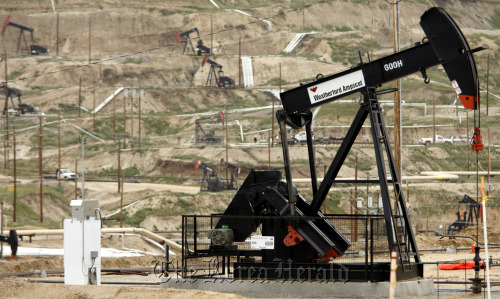'Oil prices above $100 hurt global economy, demand outlook stable'
The International Energy Agency maintained its outlook for global oil demand in 2011, while warning that prices above $100 a barrel are starting to hurt the global economy.
Worldwide oil consumption will increase by 1.4 million barrels a day, or 1.6 percent, this year to average 89.4 million a day, the Paris-based adviser said Tuesday in its monthly Oil Market Report. Still, preliminary data “already show signs of oil demand slowdown,” and global supplies are starting to look “thin” as the conflict in Libya strains OPEC members’ spare production capacity, the IEA said.
“There are real risks that a sustained $100-plus price environment will prove incompatible with the currently expected pace of economic recovery,” the agency said. “The surest remedy for high prices may ultimately prove to be high prices themselves.”
Crude futures climbed above $110 a barrel in New York for the first time in 30 months on April 7 as forces loyal to Libyan leader Muammar Qaddafi launched strikes on the country’s oil fields. Oil traded around $109 Tuesday. Monday the International Monetary Fund lowered its 2011 forecast for U.S. growth, citing the impact of fuel costs, and Goldman Sachs Group Inc. said there are “nascent signs of oil demand destruction.”
The U.S. economy, the world’s largest, will expand by 2.8 percent this year, down from the 3 percent projected in January, the IMF said. The IEA reported that “preliminary January and February data suggest that persistently high oil prices may have already started to dent demand growth.”
Societe Generale SA said Monday that growth in U.S. demand “faded to zero” in March from 600,000 barrels a day in January.
Barclays Capital said high oil prices have yet to show any “considerable” impact on oil demand, as economic conditions are different from 2008, when oil reached $147 in New York.
 |
Oil pumps stand at the Chevron Corp. Kern River oil field in Bakersfield, California. (Bloomberg) |
“It is far too premature to signal that the first signs of demand destruction are already noticeable,” Amrita Sen, London- based analyst of Barclays Capital said in a research note.
The Organization of Petroleum Exporting Countries, which supplies about 40 percent of global oil, has an “effective” spare capacity of about 3.91 million barrels a day, the IEA estimated. This level “begins to resemble the thin flexibility margin” that helped drive the rally in prices during the last decade, it said.
The producer group’s 11 members bound by quotas pumped 26.51 million barrels a day last month, the fewest since May 2010, as a result of supply losses arising from the rebellion in Libya, the agency said. Iraq is exempt from the quota system.
All 12 OPEC members will need to provide a daily average of 29.8 million barrels a day this year to satisfy global requirements, or about 600,000 a day more than they pumped in March, according to the IEA.
The IEA said producers could calm markets by selling additional crude and reducing their official sales prices.
The agency boosted its forecast for non-OPEC production this year, based on gains in output from Canada. Producers outside the organization will provide 53.7 million barrels a day in 2011, or 100,000 a day more than the IEA projected last month.
While oil stockpiles held by companies in the world’s most developed economies are currently “comfortable,” inventories could drop by December to near their lowest level in five years if present rates of demand are sustained, the agency said.
Supplies in the Organization for Economic Cooperation and Development dropped by 50.8 million barrels to 2.68 billion in February, equating to about 59.2 days worth of consumption.
(Bloomberg)








